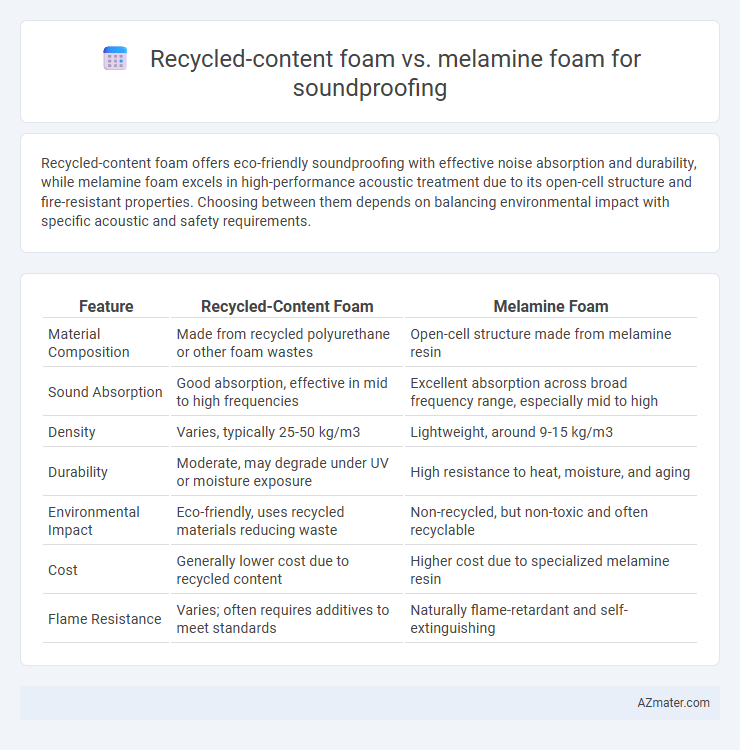Recycled-content foam offers eco-friendly soundproofing with effective noise absorption and durability, while melamine foam excels in high-performance acoustic treatment due to its open-cell structure and fire-resistant properties. Choosing between them depends on balancing environmental impact with specific acoustic and safety requirements.
Table of Comparison
| Feature | Recycled-Content Foam | Melamine Foam |
|---|---|---|
| Material Composition | Made from recycled polyurethane or other foam wastes | Open-cell structure made from melamine resin |
| Sound Absorption | Good absorption, effective in mid to high frequencies | Excellent absorption across broad frequency range, especially mid to high |
| Density | Varies, typically 25-50 kg/m3 | Lightweight, around 9-15 kg/m3 |
| Durability | Moderate, may degrade under UV or moisture exposure | High resistance to heat, moisture, and aging |
| Environmental Impact | Eco-friendly, uses recycled materials reducing waste | Non-recycled, but non-toxic and often recyclable |
| Cost | Generally lower cost due to recycled content | Higher cost due to specialized melamine resin |
| Flame Resistance | Varies; often requires additives to meet standards | Naturally flame-retardant and self-extinguishing |
Introduction to Soundproofing Foams
Recycled-content foam and melamine foam serve distinct roles in soundproofing, each offering unique acoustic benefits. Recycled-content foams are typically open-cell polyurethane materials known for their environmental sustainability and effective absorption of mid to high-frequency sounds. Melamine foam, a rigid and lightweight material, provides excellent sound absorption, particularly in high-frequency ranges, while offering fire-resistant properties ideal for specialized acoustic applications.
What Is Recycled-Content Foam?
Recycled-content foam is a sustainable soundproofing material made from repurposed polyurethane or memory foam waste, designed to reduce environmental impact while maintaining effective noise absorption properties. Unlike melamine foam, which is a rigid, open-cell structure prized for high-frequency sound dampening and fire resistance, recycled-content foam offers a softer texture and enhanced durability for mid to low-frequency soundproofing. Both foams serve distinct acoustic purposes, with recycled-content foam emphasizing eco-friendly manufacturing and resource reuse in sound control applications.
Understanding Melamine Foam
Melamine foam is a lightweight, open-cell material known for its excellent sound absorption and thermal insulation properties, making it highly effective in soundproofing applications. Unlike recycled-content foam, which often varies in density and composition, melamine foam offers consistent acoustic performance with superior noise reduction coefficients (NRC) typically ranging from 0.75 to 0.95. Its fire-resistant and moisture-resistant characteristics further enhance durability and safety in environments requiring stringent soundproofing solutions.
Acoustic Performance Comparison
Recycled-content foam offers effective sound absorption with high-density open-cell structures that dampen mid to high-frequency noise, making it ideal for general noise reduction. Melamine foam exhibits superior acoustic performance in terms of sound absorption coefficients, especially in the 500 Hz to 4000 Hz range, due to its rigid, open-cell microstructure that enhances sound wave dissipation. While both materials improve room acoustics, melamine foam tends to outperform recycled-content foam in reducing reverberation time and controlling flutter echoes in professional and industrial soundproofing applications.
Environmental Impact: Sustainability and Eco-friendliness
Recycled-content foam significantly reduces landfill waste by incorporating post-consumer materials, offering a lower carbon footprint compared to traditional synthetic foams. Melamine foam, while effective for soundproofing due to its open-cell structure, is typically derived from petrochemicals and lacks the same level of recyclability or biodegradability. Choosing recycled-content foam promotes sustainability through resource conservation and decreased environmental pollution, aligning better with eco-friendly soundproofing practices.
Durability and Lifespan
Recycled-content foam offers moderate durability with a typical lifespan of 5 to 10 years, as it can compress and degrade over time under constant pressure or exposure to moisture. Melamine foam, known for its rigid structure and resistance to heat and chemicals, generally maintains its soundproofing properties for up to 15 years or more without significant deterioration. Choosing melamine foam ensures longer-lasting acoustic performance in environments prone to wear and environmental stress compared to the more eco-friendly but less durable recycled-content alternatives.
Fire Resistance and Safety Standards
Recycled-content foam typically offers moderate fire resistance, meeting basic safety standards such as ASTM E84 Class B, but may emit harmful smoke when burned. Melamine foam excels in fire safety due to its inherent flame-retardant properties, often achieving superior fire resistance ratings like ASTM E84 Class A and low smoke toxicity. Choosing melamine foam enhances soundproofing solutions where stringent fire safety compliance and minimal smoke hazards are critical.
Installation Process and Flexibility
Recycled-content foam offers straightforward installation with its lightweight, pliable nature, allowing for easy cutting and shaping to fit various spaces and surfaces. Melamine foam, known for its rigid structure and high density, often requires precise measurement and careful placement, as it is less flexible and more prone to breakage during installation. Both materials deliver effective sound absorption, but recycled-content foam provides greater adaptability in complex or irregular architectural settings.
Cost Comparison: Which Offers Better Value?
Recycled-content foam generally offers a more cost-effective solution for soundproofing due to its lower price point and environmental benefits, making it ideal for budget-conscious projects. Melamine foam, while more expensive, provides superior sound absorption and fire resistance, justifying its higher cost in applications requiring enhanced acoustic performance and safety standards. Evaluating project requirements and long-term durability helps determine which foam delivers better value for specific soundproofing needs.
Choosing the Right Foam for Your Soundproofing Needs
Recycled-content foam offers eco-friendly sound absorption with medium density, ideal for general noise reduction in home studios and office spaces, while melamine foam provides superior open-cell structure for high-frequency soundproofing and fire resistance, suitable for professional acoustic treatment. Selecting the right foam depends on your specific soundproofing goals: recycled-content foam balances sustainability and affordability, whereas melamine foam excels in performance and safety standards. Consider factors such as noise frequency, environment, budget, and installation requirements to optimize your space's acoustic quality effectively.

Infographic: Recycled-content foam vs Melamine foam for Soundproofing
 azmater.com
azmater.com